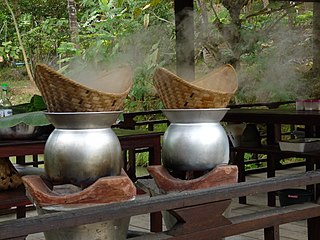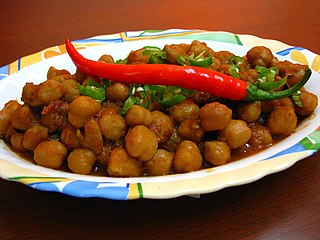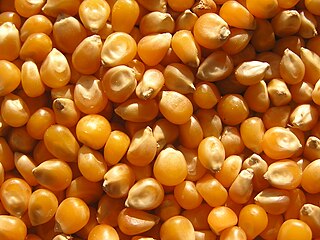
Cantonese or Yue cuisine is the cuisine of the Guangdong province of China, particularly the provincial capital Guangzhou, and the surrounding regions in the Pearl River Delta including Hong Kong and Macau. Strictly speaking, Cantonese cuisine is the cuisine of Guangzhou or of Cantonese speakers, but it often includes the cooking styles of all the speakers of Yue Chinese languages in Guangdong. On the other hand, the Teochew cuisine and Hakka cuisine of Guangdong are considered their own styles, as is neighbouring Guangxi's cuisine despite eastern Guangxi being considered culturally Cantonese due to the presence of ethnic Zhuang influences in the rest of the province. Cantonese cuisine is one of the Eight Culinary Traditions of Chinese cuisine. Its prominence outside China is due to the large number of Cantonese emigrants. Chefs trained in Cantonese cuisine are highly sought after throughout China. Until the late 20th century, most Chinese restaurants in the West served largely Cantonese dishes.

Couscous is a North African dish of small steamed granules of rolled durum wheat semolina that is traditionally served with a stew spooned on top. Pearl millet, sorghum, Bulgur and other cereals can be cooked in a similar way in other regions and the resulting dishes are also sometimes called couscous.

Moroccan cuisine is influenced by Morocco's interactions and exchanges with other cultures and nations over the centuries. Moroccan cuisine is usually a mix of Amazigh, Andalusian, and Mediterranean cuisines, with slight European and sub-Saharan influences.

Shanghai cuisine, also known as Hu cuisine, is a popular style of Chinese food. In a narrow sense, Shanghai cuisine refers only to what is traditionally called Benbang cuisine which originated in Shanghai; in a broad sense, it refers to complex and developed styles of cooking under profound influence of those of the surrounding provinces, Jiangsu and Zhejiang. It takes "colour, aroma and taste" as its elements, like other Chinese regional cuisines, and emphasises in particular the use of seasonings, the quality of raw ingredients and original flavours. Shanghai was formerly a part of Jiangsu province; as such Shanghai cuisine is most similar to Jiangsu cuisine and may still be classified as a part of Jiangsu cuisine, although it has come into more contact with Zhejiang cuisine and foreign influences as an international city. The adoption of Western influence in Shanghai cuisine developed a unique cooking style known as Haipai cuisine(海派菜).

A wok is a deep round-bottomed cooking pot that originated in China. It is common in China and similar pans are found in parts of East, South and Southeast Asia, as well as being popular in other parts of the world.

Steaming is a method of cooking using steam. This is often done with a food steamer, a kitchen appliance made specifically to cook food with steam, but food can also be steamed in a wok. In the American southwest, steam pits used for cooking have been found dating back about 5,000 years. Steaming is considered a healthy cooking technique that can be used for many kinds of foods.

Maghreb cuisine is the cooking of the Maghreb region, the northwesternmost part of Africa along the Mediterranean Sea, consisting of the countries of Algeria, Libya, Mauritania, Morocco, and Tunisia. The region has a high degree of geographic, political, social, economic and cultural diversity which influences its cuisine and culinary style.

Pilau or pilaf is a rice dish of South Asian, Central Asian and Middle Eastern origin. The recipe usually involves cooking the rice soaked in stock or broth, adding meat, spices, and other ingredients such as vegetables, and employing some technique for achieving cooked grains that do not adhere.

A tajine or tagine is a Berber dish, named after the earthenware pot in which it is cooked. It is also called maraq or marqa.

Clay pot cooking is a process of cooking food in a pot made of unglazed or glazed pottery.

Chana masala, also known as channay, chole masala, chhole masala, chhole(छोले) or chholay (plural), is a dish originating from the Indian subcontinent. The main ingredient is a variety of chickpea called chana (चना) or kala chana. They are half the diameter of typical chickpeas with a stronger flavour and texture even after being cooked.

An earth oven, ground oven or cooking pit is one of the simplest and most ancient cooking structures. At its most basic, an earth oven is a pit in the ground used to trap heat and bake, smoke, or steam food. Earth ovens have been used in many places and cultures in the past, and the presence of such cooking pits is a key sign of human settlement often sought by archaeologists. Earth ovens remain a common tool for cooking large quantities of food where no equipment is available. They have been used in various civilizations around the world and are still commonly found in the Pacific region to date.

The following outline is provided as an overview of and topical guide to food preparation:

Pot roast is a term used to describe a beef dish made by slow-cooking a usually tough cut of beef in moist heat. Tougher cuts such as chuck steak, bottom round, short ribs and 7-bone roast are preferred for this technique. These cuts are American terms; different terms and butchering styles are used throughout the Anglophone world and beyond. While the toughness of the fibers makes them unsuitable for oven roasting, slow cooking tenderizes the meat as the liquid exchanges some of its flavor with the beef.

Tunisian cuisine, the cuisine of Tunisia, consists of the cooking traditions, ingredients, recipes and techniques developed in Tunisia since antiquity. It is mainly a blend of Mediterranean and native Punics-Berber cuisine. Historically, Tunisian cuisine witnessed influence and exchanges with many cultures and nations like Italians, Andalusians, French and Arabs.

Tahdig, also known as crunchy rice, is a thin crust of slightly browned rice at the bottom of the cooking pot. It is produced during the cooking of rice over direct heat from a flame.

Beninese cuisine is known in Africa for its exotic ingredients and flavorful dishes. Beninese cuisine involves many fresh meals served with a variety of sauces. Meat is usually quite expensive, and meals are generally light on meat and generous on vegetable fat.

Gambian cuisine is part of West African cuisine and includes the culinary practices and traditions of the nation of The Gambia. Common ingredients include fish, rice, peanuts, tomato, black-eyed peas, lemon, cassava, cabbage, salt, pepper, onion, chili, and various herbs. Oysters are also a popular food from the River Gambia, and are harvested by women.


















